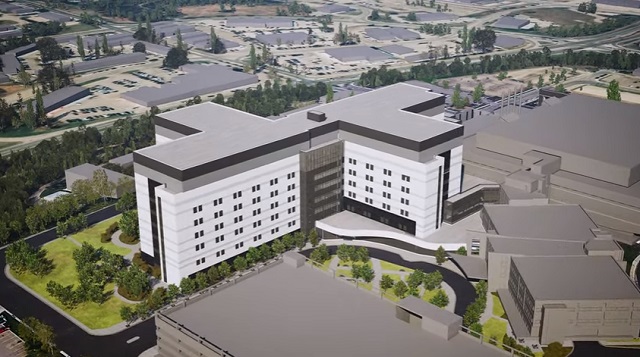Alberta
Red Deer Hospital preliminary designs unveiled

Alberta’s government shared preliminary designs of the Red Deer Regional Hospital Centre redevelopment with residents from central Alberta.
On March 14, Alberta’s government held its first public information session since January 2023 with Albertans in Red Deer and area about the Red Deer Regional Hospital Centre redevelopment. Albertans have long waited for the redevelopment and Alberta’s government made the first significant commitment and progress on the hospital by allocating $100 million in Budget 2020, followed by another $1.8-billion commitment in Budget 2022.
In addition to preliminary design drawings, residents were able to view a video simulating a flyover of the new patient tower and power plant. Project representatives were also on hand to speak about the project. The session was attended by about 150 residents, media and officials including Ken Johnston, mayor of Red Deer.
“We were excited to share preliminary designs for the Red Deer Hospital redevelopment yesterday. The number of people who attended the session validates the importance of this project to the central region. We are proud of the role Infrastructure is playing in delivering one of the most ambitious hospital redevelopment projects in Alberta’s history.”
“As the MLA for Red Deer-North and the Health Minister, I’m very proud of the progress we’ve achieved, and I remain dedicated to advocating for this project. Albertans should be able to access health care when and where they need it. This project will improve health outcomes for Albertans living in Red Deer and across central Alberta by increasing the facility’s capacity and providing much-needed services and resources, including new cardiac catheterization labs, close to home.”
Design work began in June 2023. With schematic design now complete, the hospital redevelopment is on schedule and on budget. The next stage of the project, design development, is now underway. Once complete, the new expansion will add up to 200 beds to the existing facility, bringing the total number of beds to up to 570.
“With an investment of $810 million over three years in the Budget 2024 Capital Plan, the expansion of the Red Deer Regional Hospital is Alberta’s biggest infrastructure project. Last night’s information session keeps Central Albertans informed about this exciting, transformative investment in our hospital, supporting principles of transparency and accountability in the use of taxpayer dollars.”
Quick facts
- There are two major components of this redevelopment:
- Project 1: construction of a new patient tower and expansion and renovation of the existing hospital’s main building
- Project 2: construction of an ambulatory building
- The project will upgrade several services throughout the hospital site including:
- an additional patient tower
- six new operating rooms
- new Medical Device Reprocessing department
- new cardiac catheterization labs
- renovations to various areas within the main building
- newly renovated and expanded emergency department, and
- a new ambulatory clinic building to be located adjacent to the surface parkade
Related information
Alberta
‘Weird and wonderful’ wells are boosting oil production in Alberta and Saskatchewan

From the Canadian Energy Centre
Multilateral designs lift more energy with a smaller environmental footprint
A “weird and wonderful” drilling innovation in Alberta is helping producers tap more oil and gas at lower cost and with less environmental impact.
With names like fishbone, fan, comb-over and stingray, “multilateral” wells turn a single wellbore from the surface into multiple horizontal legs underground.
“They do look spectacular, and they are making quite a bit of money for small companies, so there’s a lot of interest from investors,” said Calin Dragoie, vice-president of geoscience with Calgary-based Chinook Consulting Services.
Dragoie, who has extensively studied the use of multilateral wells, said the technology takes horizontal drilling — which itself revolutionized oil and gas production — to the next level.
“It’s something that was not invented in Canada, but was perfected here. And it’s something that I think in the next few years will be exported as a technology to other parts of the world,” he said.
Dragoie’s research found that in 2015 less than 10 per cent of metres drilled in Western Canada came from multilateral wells. By last year, that share had climbed to nearly 60 per cent.
Royalty incentives in Alberta have accelerated the trend, and Saskatchewan has introduced similar policy.
Multilaterals first emerged alongside horizontal drilling in the late 1990s and early 2000s, Dragoie said. But today’s multilaterals are longer, more complex and more productive.
The main play is in Alberta’s Marten Hills region, where producers are using multilaterals to produce shallow heavy oil.
Today’s average multilateral has about 7.5 horizontal legs from a single surface location, up from four or six just a few years ago, Dragoie said.
One record-setting well in Alberta drilled by Tamarack Valley Energy in 2023 features 11 legs stretching two miles each, for a total subsurface reach of 33 kilometres — the longest well in Canada.
By accessing large volumes of oil and gas from a single surface pad, multilaterals reduce land impact by a factor of five to ten compared to conventional wells, he said.
The designs save money by skipping casing strings and cement in each leg, and production is amplified as a result of increased reservoir contact.
Here are examples of multilateral well design. Images courtesy Chinook Consulting Services.
Parallel
Fishbone
Fan
Waffle
Stingray
Frankenwells
Alberta
Alberta to protect three pro-family laws by invoking notwithstanding clause

From LifeSiteNews
Premier Danielle Smith said her government will use a constitutional tool to defend a ban on transgender surgery for minors and stopping men from competing in women’s sports.
Alberta Premier Danielle Smith said her government will use a rare constitutional tool, the notwithstanding clause, to ensure three bills passed this year — a ban on transgender surgery for minors, stopping men from competing in women’s sports, and protecting kids from extreme aspects of the LGBT agenda — stand and remain law after legal attacks from extremist activists.
Smith’s United Conservative Party (UCP) government stated that it will utilize a new law, Bill 9, to ensure that laws passed last year remain in effect.
“Children deserve the opportunity to grow into adulthood before making life-altering decisions about their gender and fertility,” Smith said in a press release sent to LifeSiteNews and other media outlets yesterday.
“By invoking the notwithstanding clause, we’re ensuring that laws safeguarding children’s health, education and safety cannot be undone – and that parents are fully involved in the major decisions affecting their children’s lives. That is what Albertans expect, and that is what this government will unapologetically defend.”
Alberta Justice Minister and Attorney General Mickey Amery said that the laws passed last year are what Albertans voted for in the last election.
“These laws reflect an overwhelming majority of Albertans, and it is our responsibility to ensure that they will not be overturned or further delayed by activists in the courts,” he noted.
“The notwithstanding clause reinforces democratic accountability by keeping decisions in the hands of those elected by Albertans. By invoking it, we are providing certainty that these protections will remain in place and that families can move forward with clarity and confidence.”
The Smith government said the notwithstanding clause will apply to the following pieces of legislation:
-
Bill 26, the Health Statutes Amendment Act, 2024, prohibits both gender reassignment surgery for children under 18 and the provision of puberty blockers and hormone treatments for the purpose of gender reassignment to children under 16.
-
Bill 27, the Education Amendment Act, 2024, requires schools to obtain parental consent when a student under 16 years of age wishes to change his or her name or pronouns for reasons related to the student’s gender identity, and requires parental opt-in consent to teaching on gender identity, sexual orientation or human sexuality.
-
Bill 29, the Fairness and Safety in Sport Act, requires the governing bodies of amateur competitive sports in Alberta to implement policies that limit participation in women’s and girls’ sports to those who were born female.”
Bill 26 was passed in December of 2024, and it amends the Health Act to “prohibit regulated health professionals from performing sex reassignment surgeries on minors.”
As reported by LifeSiteNews, pro-LGBT activist groups, with the support of Alberta’s opposition New Democratic Party (NDP), have tried to stop the bill via lawsuits. It prompted the Smith government to appeal a court injunction earlier this year blocking the province’s ban on transgender surgeries and drugs for gender-confused minors.
Last year, Smith’s government also passed Bill 27, a law banning schools from hiding a child’s pronoun changes at school that will help protect kids from the extreme aspects of the LGBT agenda.
Bill 27 will also empower the education minister to, in effect, stop the spread of extreme forms of pro-LGBT ideology or anything else to be allowed to be taught in schools via third parties.
Bill 29, which became law last December, bans gender-confused men from competing in women’s sports, the first legislation of its kind in Canada. The law applies to all school boards, universities, and provincial sports organizations.
Alberta’s notwithstanding clause is like all other provinces’ clauses and was a condition Alberta agreed to before it signed onto the nation’s 1982 constitution.
It is meant as a check to balance power between the court system and the government elected by the people. Once it is used, as passed in the legislature, a court cannot rule that the “legislation which the notwithstanding clause applies to be struck down based on the Charter of Rights and Freedoms, the Alberta Bill of Rights, or the Alberta Human Rights Act,” the Alberta government noted.
While Smith has done well on some points, she has still been relatively soft on social issues of importance to conservatives , such as abortion, and has publicly expressed pro-LGBT views, telling Jordan Peterson earlier this year that conservatives must embrace homosexual “couples” as “nuclear families.”
-

 Carbon Tax2 days ago
Carbon Tax2 days agoCarney fails to undo Trudeau’s devastating energy policies
-

 Alberta2 days ago
Alberta2 days agoAlbertans choose new licence plate design with the “Strong and Free” motto
-

 Business1 day ago
Business1 day agoNearly One-Quarter of Consumer-Goods Firms Preparing to Exit Canada, Industry CEO Warns Parliament
-

 Health2 days ago
Health2 days agoNEW STUDY: Infant Vaccine “Intensity” Strongly Predicts Autism Rates Worldwide
-

 Alberta2 days ago
Alberta2 days agoEdmonton and Red Deer to Host 2027 IIHF World Junior Hockey Championship
-

 Daily Caller1 day ago
Daily Caller1 day agoDemocrats Explicitly Tell Spy Agencies, Military To Disobey Trump
-

 Addictions2 days ago
Addictions2 days agoActivists Claim Dealers Can Fix Canada’s Drug Problem
-

 Energy1 day ago
Energy1 day agoCarney bets on LNG, Alberta doubles down on oil













